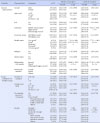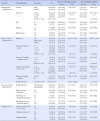Abstract
Purpose
This study was aimed to survey the actual caregiving conditions of family caregivers who are caring patients with rare and incurable diseases using home ventilators at home, and to clarify any factors affecting their burdens and quality of life.
Methods
A questionnaire survey was performed by the 159 subjects, and the questionnaires contained the actual conditions of caregiving activities, and caregiver's burdens and quality of life. The collected data was analyzed by ANOVA, Pearson's correlation, and stepwise linear regressions.
Results
The mean of burden scores was 3.55 out of 5, and influencing variables included the relationships with patient (spouse), respite (moderate), health status, and diagnosis (non ALS), with the explanatory power of 30.0%. The mean of the quality of life was 2.58 point, and the influencing variables included burdens, health status, and respite (enough), with the explanatory power of 39.0%.
Figures and Tables
Table 1
General Characteristics and Actual Conditions of Familial Caregiver and its Differences on Burden and QOL of the Familial Caregivers (N=159)

References
1. ALS Association. For people with ALS and caregivers. 2010. Retrieved May, 23, 2013. from http://www.alsa.org/als-care.
2. Chiö A, Calvo A, Moglia C, Gamna F, Mattei A, Mazzini L, et al. Non invasive ventilation in ALS: 10 yr population based study. Journal of Neurology, Neurosurgery, and Psychiatry. 2012; 83(4):377–381.
3. Choi KJ, Back HC. Burden and quality of life in caregivers of patients with rare and incurable disease. Journal of Korean Academy of Community Health Nursing. 2006; 17(3):364–375.
4. Domenech-Clar R, Nauffal-Manzur D, Perpina-Tordera M, Compte-Torrero L, Macian-Gisbert V. Home mechanical ventilation for restrictive thoracic disease: Effectson patient quality-of life and hospitalizations. Respiratory Medicine. 2003; 97(12):1320–1327.
5. Douglas SL, Daly BJ. Caregivers of long-term ventilator patients: Physical and psychological outcome. Chest. 2003; 123(4):1073–1081.
6. Eng D. Management guidelines for motor neurons disease patients on non-invasive ventilation at home. Palliative Medicine. 2006; 20(2):69–79.
7. Evans R, Catapano MA, Brooks D, Goldstein RS, Avendano M. Family caregiver perspectives on caring for ventilator-assisted individuals at home. Canadian Respiratory Journal. 2012; 19(6):373–379.

8. Given CW, Given B, Stommel M, Collins C, King S, Franklin S. The caregiver reaction assessment (CRA) for caregivers to persons with chronic physical and mentalimpairments. Research in nursing & health. 1992; 15(4):271–283.
9. Han JH, Park YH. Caregiver's burden and quality of life of male spouses with stroke wives. Korean Journal of Adult Nursing. 2012; 24(6):615–626.

10. Helpline of Rare Disease Center. 2013 Guideline of medical expenses support. 2013. Retrieved Jan, 10, 2013. from http://helpline.nih.go.kr/cdchelp/index.gst.
11. Imaiso J, Yamauchi T. Caregiver suctioning education for Japanese patients with an invasive home ventilator. Nursing and Health Sciences. 2009; 11(4):422–429.

12. Kaub-Wittemer D, Steinbuchel NV, Wasner M, Laier-Groeneveld G, Borasio GD. Quality of life and psychosocial issues in ventilated patients with amyotrophic lateral sclerosis and their caregivers. Journal of Pain and Symptom Management. 2003; 26(4):890–896.

13. Kim KB, Lee KH. The correlation among health status, burden and quality of life of the adult stroke patient's family and the elderly stroke patient's family. Korean Journal of Adult Nursing. 2001; 13(4):262–276.
14. Kim MS, Shin HI, Min YS, Kim JY, Kim JS. Correlation between severe ALS patient-caregiver couples' characteristics and caregivers' health related quality of life. Journal of Korean Academy of Nursing. 2011; 41(3):354–363.

15. Lee YS. A study of effect on quality of life of cancer patient's caregiver: Focusing on the mediating effect of feeling of burden and growth. Korean Journal of Social Welfare. 2009; 61(2):325–348.
16. López-Campos JL, Failde I, Masa JF, Benítez-Moya JM, Barrot E, Ayerbe R, et al. Factors related to quality of life in patients receiving home mechanical ventilation. Respiratory Medicine. 2008; 102(4):605–612.

17. Min SK, Lee CI, Kim KI, Suh SY, Kim DK. Development of Korean version of WHO quality of life scale abbreviated version (WHOQOL_BREF). Journal of Korean Neuropsychiatric Association. 2000; 39(3):571–579.
18. Min YS, Yong JS. Relationships among burden, social support and quality of life for the family caregiver of hemodialysis patients. Journal of Korean Academy of Psychiatric and Mental Health Nursing. 2003; 12(3):358–366.
19. Oh HJ. Psychosocial response and quality of life among amyotrophic lateral sclerosis patients and their caregivers. Korean Journal of Rehabilitation Nursing. 2011; 14(2):103–110.
20. Pack SK. A study on the burden of family caregivers of amyotrophic lateral sclerosis patients. Seoul: Yonsei University;2005. Unpublished mater's thesis.
21. Park YH, Yu SJ, Song MS. Caregiver burden of families with stroke patients and their needs for support group intervention. Journal of Korean Academy of Adult Nursing. 1999; 11(1):119–134.
22. Rice R. Home care nursing practice: Historical perspectives and philosophy of care. In : Rice R, editor. Home care nursing practice: Concepts and application. St. Louis: Mosby, Inc;2006. p. 3–15.
23. Shim JY, Lee JK, Kim SY, Won JW, Sun WS, Park HK, et al. The development of Korean health related quality of life scale. Korean Journal of Family Medicine. 1999; 20(10):1197–1208.
24. Shin HI. 2008 Survey of ventilatory support in patients with rare and incurable disease. 2011. Retrieved April, 23, 2013. from http://www.cdc.go.kr/CDC/notice.
25. Srinivasan S, Doty SM, White TR, Segura VH, Jansen MT, Davidson Ward SL, et al. Frequency, cause, and outcome of home ventilator failure. Chest. 1998; 114(5):1363–1367.
26. Thornton AA, Perez MA. Posttraumatic growth in prostate cancer survivors and their partner. Psychooncology. 2006; 15(4):285–296.
27. Tsara V, Serasli E, Voutsas V, Lazarides V, Christaki P. Burden and coping strategies in families of patients under noninvasive home mechanical ventilation. Respiration. 2006; 73(1):61–67.

28. Yoon MH, Choi-Kwon SM. Quality of life and the factors related to family caregivers caring for those with amyotrophic lateral sclerosis. Perspectives in Nursing Science. 2011; 8(1):62–72.




 PDF
PDF ePub
ePub Citation
Citation Print
Print





 XML Download
XML Download